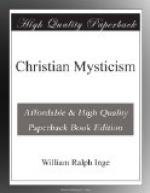The Divine in Nature has hitherto been discerned more fully by the poet than by the theologian or the naturalist; and in this concluding Lecture I must deal chiefly with Christian poetry. The attitude towards Nature which we have now to consider is more contemplative than practical; it studies analogies in order to know the unseen powers which surround us, and has no desire to bend them or make them its instruments.
Our Lord’s precept, “Consider the lilies,” sanctions this religious use of Nature; and many of His parables, such as that of the Sower, show us how much we may learn from such analogies. And be it observed that it is the normal and regular in Nature which in these parables is presented for our study; the yearly harvest, not the three years’ famine; the constant care and justice of God, not the “special providence” or the “special judgment.” We need not wait for catastrophes to trace the finger of God. As for Christian poetry and art, we do not expect to find any theory of aesthetic in the New Testament; but we may perhaps extract from the precept quoted above the canon that the highest beauty that we can discern resides in the real and natural, and only demands the seeing eye to find it.
In the Greek Fathers we find great stress laid on the glories of Nature as a revelation of God. Cyril says, “The wider our contemplation of creation, the grander will be our conception of God.” And Basil uses the same language. We find, indeed, in these writers a marked tendency to exalt the religious value of natural beauty, and to disparage the function of art—a premonition, perhaps, of iconoclasm. Pagan art, which was decaying before the advent of Christ, could not, it appears, be quietly Christianised and carried on without a break.
The true Nature-Mysticism is prominent in St. Francis of Assisi. He loves to see in all around him the pulsations of one life, which sleeps in the stones, dreams in the plants, and wakens in man. “He would remain in contemplation before a flower, an insect, or a bird, and regarded them with no dilettante or egoistic pleasure; he was interested that the plant should have its sun, the bird its nest; that the humblest manifestations of creative force should have the happiness to which they are entitled.[367]” So strong was his conviction that all living things are children of God, that he would preach to “my little sisters the birds,” and even undertook the conversion of “the ferocious wolf of Agobio.”
This tender reverence for Nature, which is a mark of all true Platonism, is found, as we have seen, in Plotinus. It is also prominent in the Platonists of the Renaissance, such as Bruno and Campanella,[368] and in Petrarch, who loved to offer his evening prayers among the moonlit mountains. Suso has at least one beautiful passage on the sights and sounds of spring, and exclaims, “O tender God, if Thou art so loving in Thy creatures, how fair and lovely must Thou be in Thyself![369]” The Reformers, especially Luther and Zwingli, are more alive than might have been expected to the value of Nature’s lessons; and the French mystics, Francis de Sales and Fenelon, write gracefully about the footprints of the Divine wisdom and beauty which may be traced everywhere in the world around us.




